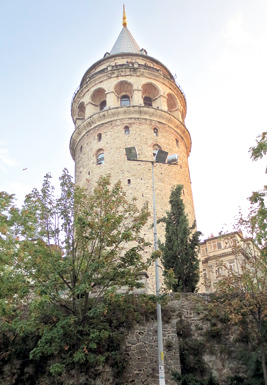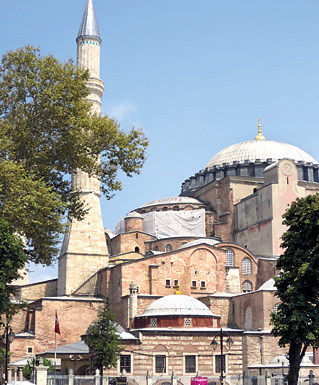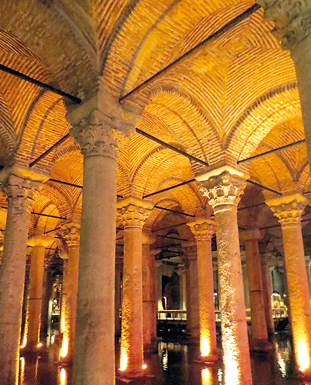Stepping into the old soul of Turkey
The past is just a glance away. Alongside the busy highways and crowded streets are the magnificent reminders of Istanbul’s storied past. For this modern city was once Byzantium to the Greeks, then Constantinople, the capital of the Eastern Roman Empire, and subsequently came to be known as Istanbul, the heart of the Ottoman Turkish Empire until in 1923, Mustafa Kemal Ataturk, the father of modern Turkey founded the Turkish Republic. Ataturk made Ankara the capital city but Istanbul natives are convinced that their city is the soul of Turkey.

Watching over Istanbul: The conical Galata Tower
On the smooth drive in from the airport, we are struck by how ancient and modern dwell side by side. On our right the sparkling waters of the Marmara sea are dotted with ships waiting to sail through the Bosphorus as did the seafarers of yore. Later, heading to the old city, we are stuck behind a long line of heavy trucks carrying sand for land reclamation work and on the left, we see the remains of the old city walls, weathered by the winds of centuries. In the old city, slender minarets and stately domes of mosques dot the skyline, and exotic markets and vast palaces beckon visitors to explore.
Istanbul is a veritable Aladdin’s cave for the traveller with a thirst for history. Here in our two part series we take a stroll through some of the city’s varied attractions.
Galata Tower
There can be many starting points but perhaps the Galata Kulesi (Galata Tower) where you have a panoramic view from 205 feet above ground of the vast sprawl of Istanbul, the Bosphorus and the Golden Horn would suffice to give you some perspective. A lift transports you almost to the top where a short flight of stairs gets you to the narrow balcony where jostled by a crush of camera-heavy people you circle gingerly taking in the view and the sunlight glimmering on the Golden Horn. The Genoese built the tower in 1348 and during the Ottoman Empire it was used as a prison. Now you can dine at the restaurant in the tower but the square below, where there is a flavour of Italy in the coffee shops and quaint cafes seems a more inviting prospect.
Hagia Sophia
As if to whet our interest on the journey to Istanbul, the inflight magazine of Turkish Airlines had as its cover story ‘Hagia Sophia: Mosque of the Sultans’ (Ayasofya: Sultanlarincamii). Indeed no visit to Istanbul would be complete without seeing the sheer grandeur of this monument that along with the Blue Mosque is an enduring symbol of the city. Enduring because it has been through earthquakes, fire and riots. Hagia Sophia was built by Constantine the Great who after embracing Christianity wanted a cathedral befitting his new capital Constantinople. Built in 360AD, it was first named ‘The Great Church’. But twice burnt down in 404AD and 532 AD during revolts and riots, the current building was built by Emperor Justinian not in its previous form as a Western cathedral but reflecting the splendour of Byzantine architecture. Justinian was a man in a hurry. He had 10,000 work at speed, utilizing stone from Egyptian quarries in Porphyry, black stone from the Bosphorus, green marble from Thessaly, and yellow rock from Syria to complete construction in five years. Completed in 537 AD, it was christened the Hagia Sophia (‘Church of the Holy Wisdom of God’).

A view of the Hagia Sophia
The Hagia Sophia was the largest cathedral in the world for almost a thousand years –from 537AD to 1527AD. However with the conquest of Istanbul during the Fourth Crusade from 1204, it became a Catholic Basilica and suffered disastrous damage during the last period of Byzantine rule. Massive restoration under the Ottoman Empire and Sultan Mehmet II saw it take its place as the pride of Islam- a ‘Cami-i-Kebir’ ( Great Mosque). Its famous mosaics save that of the Virgin Mary were plastered over. Recent restoration has revealed only some long lost, like the face of one of the four six-winged seraphim. Succeeding sultans built the library, primary school, hospice and the signature fountain in the forecourt.
In 1934, Hagia Sophia became a museum, which is what it is today, to the thousands of visitors who walk through its doors. But as your eyes turn upward and you see the impressive mosaics of Christ (the most famous- the Deisis ‘Invocation’, though partially destroyed is considered a wonderful example of Byzantine mosaic ) and the Virgin Mary, then the prominent Islamic calligraphy panels high on the columns, it is impossible to disregard that this has been a holy place, a sacred centre of worship for centuries.
The Blue Mosque
To the people of Istanbul it is Sultanahmet Camii, the Blue Mosque being the visitors’ appellation. Built during the reign of Sultan Ahmet I (1603-1617), it was Islam’s answer to Hagia Sophia. Its six slender minarets make it easily identifiable and if its architectural grandeur awes you from outside, nothing quite prepares you for the magnificence within. The huge dome (180 feet high and 102 feet wide) compels your eyes upwards and the blue of the intricate Iznik tiles highlighted by the light filtering through the many windows gives it its celestial appearance. The floral pattern on the more than 21,000 tiles in its interior is meant to represent spring as well as the gardens of Paradise, according to a brochure. Tulips, our guide tells us, are a predominant motif here.
The Blue Mosque is still a centre of worship and visitors can enter, albeit suitably clad. For women this means a head covering and no short skirts; for men, no shorts. Head scarves and wraps are provided at the entrance and also plastic bags in which to carry your footwear. Handmade carpets cover the floor, chandeliers with many lamps light the interior.
If time permits (our schedule sadly did not), drop by the Imperial Pavilion where fine examples of Turkish carpets – Usak, Bergama and Konya samples, dating back to the 16th and 19th centuries are on display.
Basilica Cistern (Yerebatan Sarayi)
Whether Dan Brown is on your list of favourite authors or not, there’s no denying he has an unerring eye for fascinating locales. His latest book ‘Inferno’ jets from Renaissance Florence and Venice to underground Istanbul –the Basilica Cistern. This marvel of Roman engineering – dating back to 532 AD, was built by Emperor Justinian and could hold 100,000 tons of water, providing ample supply to the Palace and neighbouring areas. The water was brought from the mountains by way of aqueducts.

Amazingly intricate: The grand interior of the Blue Mosque
The entrance to the Cistern is nondescript, but descend a few stairs to the dimly lit cavern – and be astounded by the graceful stone and marble colonnades (some 336 columns, Doric and Corinthian). Disused during the late Ottoman era, only a major restoration undertaken as recently as the 1980s has brought out its many features.
It’s not just Dan Brown who found it fascinating: The Sunken Palace as it is also known figured in ‘From Russia With Love’- that old Bond movie of the ‘60s.
Wooden walkways allow visitors to explore its damp and slightly spooky interior. A walk to the far end brings you to the Medusa heads from the Temple of Apollo in Didyma. Other columns are also believed to have been carted off from Roman temples. Now it holds just a few feet of water and the odd goldfish but imagine when it was full. Amazingly, the Basilica Cistern though the most famous is just of one of 300 cisterns in the city.
The Grand Bazaar
It’s touristy, there’s no denying it but it’s hard not to succumb to the lure and in fact not get lost in this massive ancient market. Carpets, ceramics, jewellery, leather goods, lanterns and souvenirs are piled in grand profusion and the shopkeepers (there are some 4,000 stalls here) are beguiling, homing in immediately on tourists.
The Grand Bazaar was built in 1461 and is said to be one of the largest covered markets in the world. Earlier particular sections were dedicated to certain goods, but now it is largely, all mixed up, though a sortie in search of books, led us to a peaceful alley where a row of booksellers reigned; alas books in English were scarce. Outside though, the Grand Market’s appeal palls when you are accosted by over-eager boys selling fake designer perfumes and bags.
The Spice Market
Perhaps because it was the first stop on our tour, our entre to the delights of Istanbul, this market dating back to 1663, also known as the Egyptian market retains a particular magic. It is a banquet for the eye- whether nuts, spices, dates, olives, coffee or the ubiquitous Turkish delight, the offerings are so plenteous and displayed with such glorious aplomb, that only the iron-willed can sail past without being tempted to stop. Tastes are freely, generously offered.

Roman masterpiece: The columns and arches of the Basilica Cistern
The Spice Market is adjoining the New Mosque (all of 400 years old), another beauty of half domes topped by one grand dome and a great courtyard where pigeons walk with pedestrians.
(More sights of Istanbul next week).
(The Sunday Times was part of a Turkish Airlines media tour to Istanbul)
comments powered by Disqus

